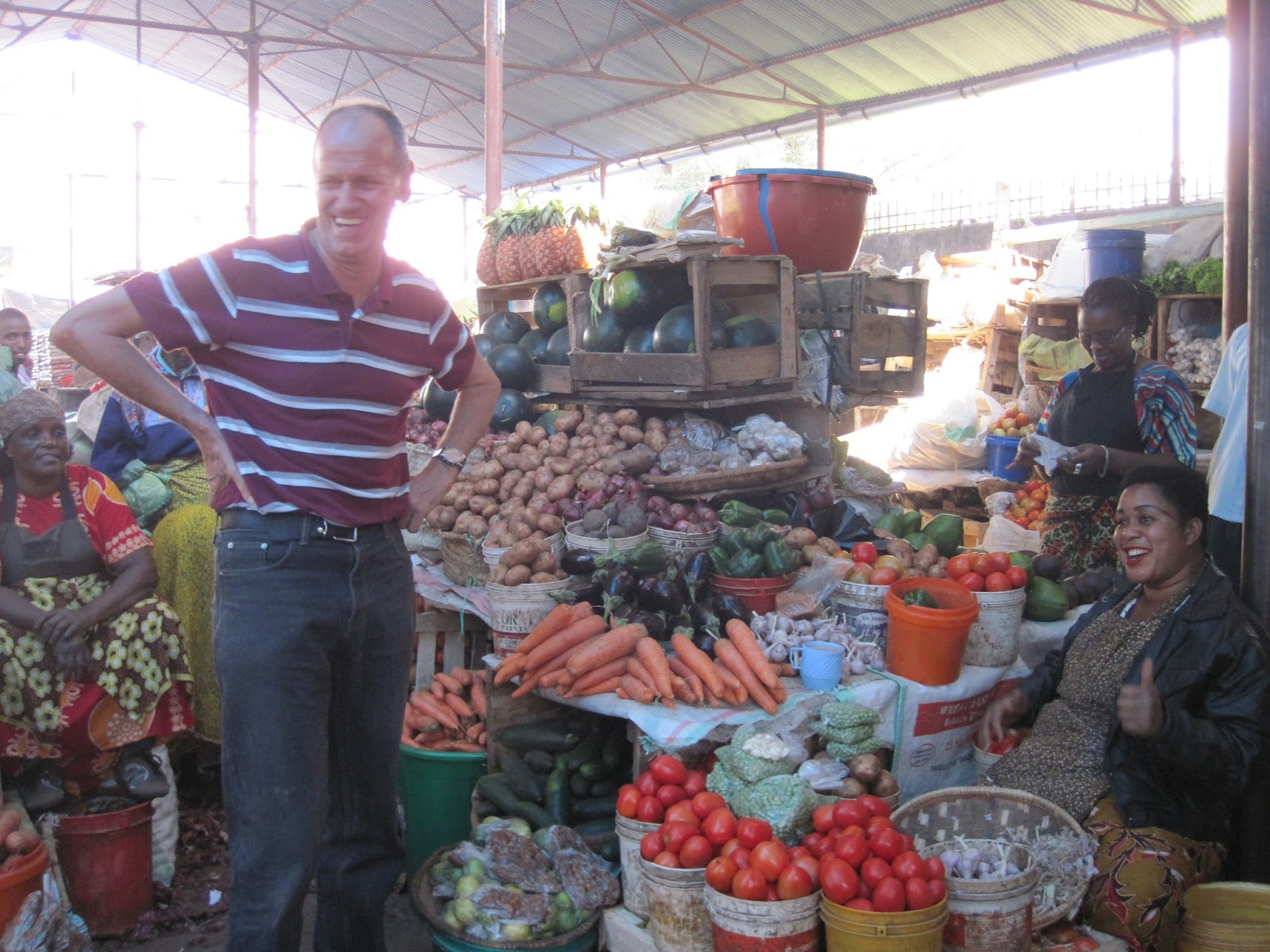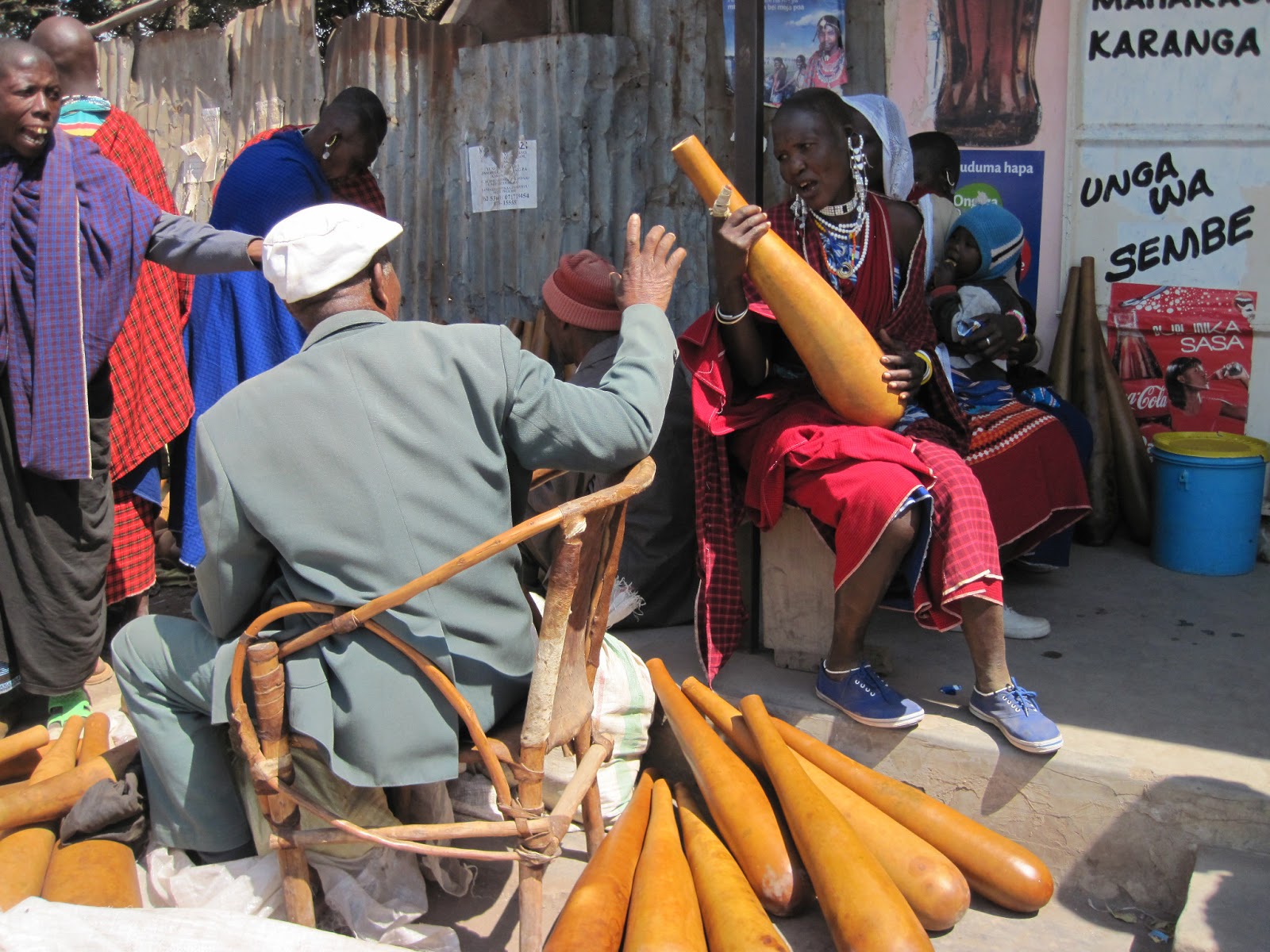Our last days in Arusha included a walking and driving safari in Arusha National Park, shopping with the lodge owner (Art), and riding along to go pick up Tammy, Mike, and Abby as they came off Kilimanjaro.
Arusha National Park
We were a little hesitant about spending the money to go on
a one-day safari given we knew we had 10 days already planned, but we thought
it could be fun to do it for the first time with just the two of us.
Once again, Peter helped us with our trip. Instead of joining us, he hired us a driver
for the day. Our driver was Dawson Minja—an
older man who had many years experience guiding in the Serengiti and Ngorongoro
Crater.
 Arusha National Park is lush and beautiful! Supposedly, it’s the only park in the region that
has water year round and an intact native forest. This is partly why we wanted
to go. As soon as we entered the park,
we instantaneously saw vervet monkeys and baboons.
Arusha National Park is lush and beautiful! Supposedly, it’s the only park in the region that
has water year round and an intact native forest. This is partly why we wanted
to go. As soon as we entered the park,
we instantaneously saw vervet monkeys and baboons.
When we came upon our first meadow, Minja finally pulled
over to allow us our first glimpse of zebra and water buffalo. As expected, we were quite excited! The meadow had a few trees with Mt. Meru as a
backdrop. In many ways, it seemed almost
too perfect.
Our walking guide was named Clever. We asked him to spell his name partly because
we couldn’t tell if he’d said his name was Cleaver or something else. The name “Clever” was good fun. He was nice, but he wasn’t necessarily the
best at identifying the birds we were spotting.
He essentially called them all tropical bou bou birds (some of them were
– we checked – but, not all!). He was
quite good at spotting mammals and identifying plants, often with an
interesting explanation of their medicinal or cultural use.
 We were not in a zoo (what???). Sometimes animals are not
terribly visible or findable. That
seemed to be the case for our walking safari.
We did try. Our efforts involved
walking through sludge (translation: muddy wetland) in search of monkeys and up
a steep hillside to spy giraffe, we only saw water buffalo and baboons running
across the field in the distance during the beginning of our hike. We also had an encounter with a warthog. It was scary and far too close. Our surprise/fear meant that neither of us
got our camera’s up.
We were not in a zoo (what???). Sometimes animals are not
terribly visible or findable. That
seemed to be the case for our walking safari.
We did try. Our efforts involved
walking through sludge (translation: muddy wetland) in search of monkeys and up
a steep hillside to spy giraffe, we only saw water buffalo and baboons running
across the field in the distance during the beginning of our hike. We also had an encounter with a warthog. It was scary and far too close. Our surprise/fear meant that neither of us
got our camera’s up. The walk was not only pretty, but it provided a nice
opportunity to finally be outside in the lush forest. The meadows and forest were amazing and
Arusha National Park is one of the few parks with a “natural” forest. I think we were partly happy just to get some
exercise. Clever did not take the hill
entirely “pole pole.”
The walk was not only pretty, but it provided a nice
opportunity to finally be outside in the lush forest. The meadows and forest were amazing and
Arusha National Park is one of the few parks with a “natural” forest. I think we were partly happy just to get some
exercise. Clever did not take the hill
entirely “pole pole.” The driving safari resulted in animals being both findable
and close-by. We lamented the fact that
we had not gotten a good look at either the baboon or giraffe. It did not take long to realize that this
would not persist as a challenge. The
other fun aspect of the game drive was the ability to stand and have your head
out of the top. We felt a bit like dogs
hanging our heads out of the car, but it was great fun. We’re going to let the photos explain the
rest (Adrienne’s “happy snaps” at least, you’ll have to wait for Dina’s).
The driving safari resulted in animals being both findable
and close-by. We lamented the fact that
we had not gotten a good look at either the baboon or giraffe. It did not take long to realize that this
would not persist as a challenge. The
other fun aspect of the game drive was the ability to stand and have your head
out of the top. We felt a bit like dogs
hanging our heads out of the car, but it was great fun. We’re going to let the photos explain the
rest (Adrienne’s “happy snaps” at least, you’ll have to wait for Dina’s).
Shopping with Art
Art is the Dutch owner of Ilboru Safari Lodge. He has been in Tanzania for 15 years and is married to a Tanzanian woman. He offered to let us come along for his standard shopping trip for the lodge. It was great fun. We were joined by two Dutch tourists for the trip. Art provided colorful commentary throughout the trip.
It began with a stop at an electrical store for items needed for repairs and then proceeded to a bakery to collect the baguettes that were sliced and served at dinner. We also hit a “supermarket” that was really a fairly small grocery store for some items including lentils for Dina’s photography bean-bag and shampoo to replace the one that exploded (our hair needed this).
Our final stop was the market. Although we had visited the market with Peter, our visit with Art showed us how little of the market we had actually seen. We began at the women’s area for fruit and vegetables, then to the men’s area for more (yes, they were gender separated), then found fish, and finally went to the butcher. The butcher was great fun and LOVED having his picture taken. Observations included:
Art is the Dutch owner of Ilboru Safari Lodge. He has been in Tanzania for 15 years and is married to a Tanzanian woman. He offered to let us come along for his standard shopping trip for the lodge. It was great fun. We were joined by two Dutch tourists for the trip. Art provided colorful commentary throughout the trip.
It began with a stop at an electrical store for items needed for repairs and then proceeded to a bakery to collect the baguettes that were sliced and served at dinner. We also hit a “supermarket” that was really a fairly small grocery store for some items including lentils for Dina’s photography bean-bag and shampoo to replace the one that exploded (our hair needed this).
Our final stop was the market. Although we had visited the market with Peter, our visit with Art showed us how little of the market we had actually seen. We began at the women’s area for fruit and vegetables, then to the men’s area for more (yes, they were gender separated), then found fish, and finally went to the butcher. The butcher was great fun and LOVED having his picture taken. Observations included:
- Art expressed lament at the treatment of white men. He explained that white men are presumed wealthy and viewed as a means to improve the life of children. He noted that he had to be careful in the women’s area of the market.
- Art did not purchase any smoked fish. Evidently, some merchants smoke fish by burning tires, trash, and other assorted items that infuse the fish with a toxic brew of contaminants.
- Tanzanians, particularly Maasai, prefer fatty meat, not filets. That means that the cuts preferred by western tourists are often the cheapest (ha!).

Picking up the Rest of the Crew
Happily we were able to join Digland and the African Walking Company folks to pick up Mike, Tammy, and Abby. After a few hours, we parked in a village and Digland hopped out telling us that we could sit and wait. Dina and I looked at the meager waiting area and immediately asked if we could just walk up the road that our friends would be descending. Digland gave us a reluctant “yes” and turned to walk with us. It turns out that he was not permitted to allow us to walk unescorted in the village. We felt badly that we took him from his duties of dealing with the porters as they arrived, but he assured us that it was all right.
Happily we were able to join Digland and the African Walking Company folks to pick up Mike, Tammy, and Abby. After a few hours, we parked in a village and Digland hopped out telling us that we could sit and wait. Dina and I looked at the meager waiting area and immediately asked if we could just walk up the road that our friends would be descending. Digland gave us a reluctant “yes” and turned to walk with us. It turns out that he was not permitted to allow us to walk unescorted in the village. We felt badly that we took him from his duties of dealing with the porters as they arrived, but he assured us that it was all right.
 |
| Porters heading up to bring food to groups on the mountain. |
 |
| Mike and Tammy descending from Kilimanjaro. |



































